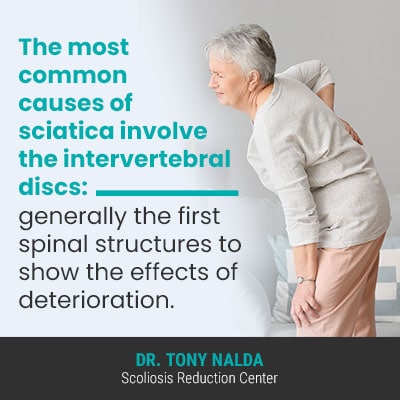Sciatic nerve pain is caused by compression, irritation, inflammation, and pinching of a nerve in the lumbar spine. The most common cause of a sciatica flare-up is a herniated or slipped disc in the lower back. Many people’s sciatica resolves on its own, but some cases require proactive treatment driven by its underlying cause.
Sciatica involves nerve compression and irritation, causing pain felt anywhere along the sciatic nerve’s pathway. Sciatica can range from mild and intermittent, with periodic flare-ups, to chronic and debilitating. Alleviating sciatica symptoms involves treatment that addresses its underlying cause.
Let’s start our discussion of sciatica by first exploring some basic spinal anatomy to better understand how spinal nerves function, then we can look into options to relieve pain.
Anatomy of the Spine
The spine has three main sections – cervical (neck), thoracic (middle/upper back), and lumbar (lower back).
When viewed from the sides, a healthy spine will have a soft ‘S’ shape; when viewed from the front or the back, it will appear straight, and this is due to its natural and healthy curves, making it stronger, more flexible, and better able to absorb stress.
Each spinal section has a characteristic curvature type, and a spine that can maintain its natural curves and range of motion is a spine that stays aligned and functions well. If the spine loses one or more of its natural curvatures, its entire biomechanics is disrupted.
The spine is made up of vertebrae (bones) that are rectangular in shape and stacked on top of one another in a straight alignment and are separated by intervertebral discs.
The intervertebral discs perform many important roles, including providing the spine with structure, cushioning between adjacent vertebrae, enabling flexible movement, and acting as its shock absorbers.
The vertebrae have hollow openings in their centers, forming a canal through which the spinal nerves travel and branch out to different areas of the body.
Remember, the brain and spine work in tandem to form the body’s central nervous system (CNS), which is why spinal conditions can cause such a wide range of symptoms felt throughout the body, both physical and neurological.
Conditions like sciatica involve irritation felt at the root of a nerve, where it exits the spine, or anywhere along its pathway, which is extensive.
The Sciatic Nerve

You may be wondering “What is your sciatica nerve?” The sciatic nerve is part of your body and sciatica is the condition.
The sciatic nerve is the largest and longest nerve in the human body; it’s a mixed nerve consisting of both sensory and motor fibers, originating in the lumbar spine and extending down the buttock, leg, and into the foot.
In most cases, sciatica involves one side of the body, most commonly the left, but can involve both.
The structure of nerves is similar to branches on a tree, fanning off in multiple directions, which is why nerve pain can be felt anywhere along an affected nerve’s pathway and far from its site of origin.
What Causes Sciatica Pain to Flare Up?
Sciatica involves pain and discomfort felt anywhere along the sciatic nerve’s pathway and can involve localized lower back pain, and/or radicular pain felt throughout the lower body, most commonly in the buttock and down the back of a thigh and calf.
Sciatic nerve pain can feel sharp, hot, or like electric shocks. It can also involve sensations of numbness or tingling.
Prolonged periods of sitting can aggravate the condition and lead to flare-ups, particularly if the body posture is not ideal.
When the sciatic nerve, either at its root or anywhere along its pathway, is exposed to uneven force, it can become compressed, pinched, inflamed, irritated, impinged, and/or damaged: causing pain and discomfort.
The lower back is responsible for supporting the weight of the trunk and spinal sections above; it also feels the effects of lifting, turning, twisting, and bending motions, which is why at some point, it’s likely that everyone will experience some form of lower back pain.
Nerve-related back pain is commonly thought to be the most potentially debilitating form of back pain, and sciatic nerve pain can range from mild and intermittent, to chronic and debilitating. For some people the pain intensifies at night and others also experience leg pain.
Sciatica flare-ups can be triggered by various factors, including underlying conditions like hyperlordosis and dextroscoliosis, which can exacerbate nerve compression and lead to increased pain and discomfort.
Understanding what causes sciatica to flare up, especially when it’s related to conditions like retrolisthesis, and hip pain is essential for effective management; this comprehensive guide offers insights into the causes and provides solutions for relief.
The connection between scoliosis and sciatica flare-ups raises the question of whether scoliosis can cause neuropathy, as both conditions can contribute to nerve compression and discomfort in the spine.
The cause of flare-ups is the condition’s underlying cause, which is why it’s important to ensure treatment plans don’t solely address pain as a symptom rather than treating the underlying cause of pain: the condition itself.
What are the Most Common Sciatica Causes?
The most common causes of sciatica involve the intervertebral discs: generally the first spinal structures to show the effects of deterioration.

A bulging or herniated disc, whether caused by injury or natural age-related spinal degeneration, can greatly affect the spine’s ability function, and is connected to nerve compression, irritation, inflammation, and/or impingement.
Other common causes involve lumbar spinal stenosis and spondylolisthesis. While sciatica flare-ups can be caused by any of the aforementioned spinal issues/conditions, disc herniation is the most common, with some studies showing that up to 90 percent of sciatic nerve pain is related to disc herniation in the lower back.
When a disc bulges, this means it has changed its shape, most often due to age-related degenerative changes like disc desiccation, and is bulging outwards, intruding on the space within the spine.
When a disc herniates, its soft inner nucleus protrudes through a tear in the disc’s tough outer annulus, encroaching on the spaces within the spine, occupied by nerve roots, and when a nerve root is pushed against by a herniated disc, it can become irritated, inflamed, pinched and painful.
When spinal stenosis is the cause, this condition involves the narrowing of space within the spine, causing uneven pressure on the spinal nerves housed within.
Spondylolisthesis is a condition of spinal instability involving the slipping forward of one vertebral body onto the one below, causing misalignment and related nerve compression, and is another cause of sciatica.
Sciatica Treatment Options
So now that we have explored some basic spinal anatomy and defined sciatica, its symptoms, and common causes, what are some effective sciatica treatment options?
Here at the Scoliosis Reduction Center®, I have experience treating a wide range of spinal conditions, sciatica included.
Once I comprehensively assess a patient and determine the underlying cause of their sciatic nerve pain, I craft a customized treatment plan around it. This goes beyond just trying to relieve sciatic pain.
Through a conservative chiropractic-centered treatment approach, I integrate different treatment modalities to impact sciatica on multiple levels: isolating and addressing any areas of vertebral subluxation, and also working to relieve sciatica pain.
While disc damage is difficult to reverse, I can make improvements to their surroundings for increased nutrient absorption through osmosis for enhanced disc health and function. In addition, through condition-specific chiropractic care, I can help a disc reclaim its central position between adjacent vertebrae by addressing any related vertebrae that are misaligned with the rest of the spine and in need of adjustment.
Certain chiropractic techniques can also be applied to increase the space between vertebral bodies, taking pressure off impinged nerves.
A variety of physical therapy exercises can also help improve circulation and disc health, thereby addressing a common underlying cause of sciatic nerve pain and allowing you to get sciatica pain relief.
Condition-specific physical therapy exercises can also help increase core strength, so the spine receives optimal support and stabilization from its surrounding muscles: taking pressure off the spine and its structures, such as the intervertebral discs.
By letting the underlying cause of sciatic nerve pain guide the customization of treatment plans, I’m treating the condition itself, rather than just its symptoms.
Conclusion
The spine is a key component of the human anatomy; it gives the body structure, allows us to stand upright, engage in flexible movement, and absorb mechanical stress incurred during movement. It also works in tandem with the brain to form the central nervous system.
Part of the spine’s complex nature is related to its movement-based design and many moveable parts, such as its intervertebral discs.
While a variety of spinal conditions such as stenosis and spondylolisthesis can also cause sciatica, the condition is most commonly caused by intervertebral disc degeneration: desiccated, bulging, or herniated discs in the lumbar spine.
What causes sciatica to flare up is a pinched nerve root or uneven forces felt anywhere along the path of the sciatic nerve; the underlying cause of the pinched nerve, whether it be a disc issue, spinal condition, or injury is the cause of the sciatica flare-up.
While there are no treatment guarantees, the best way to address sciatica is through proactive treatment delivered under a conservative chiropractic-centered approach.
Here at the Scoliosis Reduction Center®, I integrate multiple forms of condition-specific treatment such as chiropractic care, in-office therapy, and custom-prescribed home exercises to craft a treatment plan driven by a condition’s causation.





